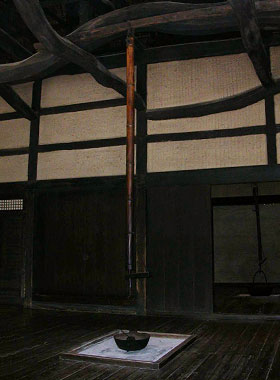Also written 居炉裏. Also called ro 炉. An open
hearth set in the floor of various rooms in Japanese buildings. Believed by some
to have referred originally to the periphery of the hearth, the term was generally
used for the hearth itself. It provided heat, light and in many cases a place
for cooking suiji 炊事. For cooking purposes, pots or kettles were either
placed upon tripods, or suspended from the beams above the heat using an adjustable
hook *jizaikagi 自在鈎
which might be decorative. Irori size varied from around 45x45cm (in teahouses)
to 2mx1m, with 90x90cm being the average. The irori was usually square.
There were two main types. The simplest was a pit excavated directly in the surface
of the ground, partially backfilled with sand and ash and edged with stones or
timber. This kind of irori was common in the poorer vernacular houses
*minka 民家, of the Edo period,
which had a low floor of rice husks and reed matting *doza
土座 instead of a raised floor. This type resembles the hearths unearthed in excavations
of prehistoric pit dwellings *tateana
juukyo 竪穴住居. The second type of irori was constructed into the
raised timber floor, takayuka 高床, and edged with timber or occasionally
stone. A mound of stones and earth brought up to the level of the underside of
the floor formed the base. A hollow fire pit, usually lined with plaster *shikkui
漆喰, was then made in the center of this base. The irori was already in
use in the upper class residences of the Heian period, where it was termed *jihiro 地火炉. It was also
found in shoin style residences *shoin-zukuri 書院造,
especially in service rooms such as the kitchens *daidokoro
台所, *kiyodokoro 清所, and
in style rooms *sukiya 数寄屋,
and tea houses *chashitsu
茶室. In minka it was found not only in the kitchen, but also in the center
of the main living room *hiroma
広間, *oue 御上, where it was a
focus of everyday life around which meals were eaten and informal visitors entertained.
The sitting arrangement around the irori in minka was fixed: the
seat at the upper end *kamite
上手, overlooked the earthfloored area *doma
土間, called the *yokoza 横座,
was for the master of the house. The seat opposite him, called variously *kijiri
木尻, hijiri 火尻, or *shimoza 下座, was the lowest in rank and was used
by junior family members, dependents and servants, or for fuel storage. The seat
toward the rear of the house, closest to the kitchen area, was the wife's seat
*nyoubouza 女房座, ubaza
うば座, kakaza かか座, tanamoto 棚もと. The seat opposite her (nearest to
the entry in *hirairi 平入
houses) was used by visitors or by the eldest son and was called *kyakuza
客座, mukouza 向座, or otokoza 男座. All of these seats have a wide variety
of local names. The irori was a feature of minka in almost all parts
of the country, and in Touhoku 東北 region, it was quite common for houses to have two. An
exception was the Kinki 近畿 region around Nara, Kyoto and Osaka, where, from the
mid-Edo period, the irori virtually ceased to be used in the vicinity of
major urban areas. Irori has a wide range of regional names and pronunciation
variants, of which the main ones are yururi ゆるり, yurui ゆるい, irui
いるい, yuri ゆり, iri いり, ennaka えんなか, hinata ひなた, hitakijiro
火焚き地炉, hijiro 火地炉.
|



